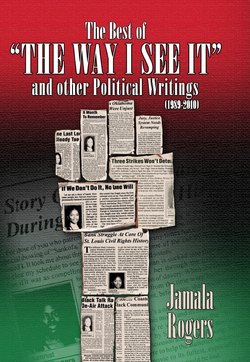Читать книгу The Best of "The Way I See It" and Other Political Writings (1989-2010) - Jamala Rogers - Страница 17
На сайте Литреса книга снята с продажи.
Lift Every Voice, Then We Can Sing
ОглавлениеMarch, 2000
You all know by now that I don’t stay between the lines. For example, I believe African people in America can celebrate their story any time and any place. This month, I want to tell you about Lift Every Voice and Sing. It is a phenomenal project that highlights the life and times of 100 black St. Louisans.
Ann Morris and Doris Wesley were responsible for the writing and editing of the powerful narratives told in the words of the chosen few. Award-winning photographer, Wiley Price, brought the text into visual form by capturing the subjects’ moods and personalities in black and white photos. You will recognize a few household names and sometimes their story - people like William Clay, Sr., Bernie Hayes, Ora Lee Malone, Percy Green, Donald Suggs, Betty Thompson, Mae Wheeler, Oliver Sain, or Pearlie Evans. There are also many unsung heroes and sheroes.
Their stories are not only inspiring, but make you want to do more research and study. They could be a really cool teaching tool, especially because many of the “Voices” are still alive. Kids can actually meet and talk to them in the flesh.
I felt as if I were right there with Mr. Weldon Young in his bid to become the first black engineer at Vashon High School during the Depression years. I wonder what happened to the Oblate Sisters of Normandy, a black order of nuns that Olivia Calloway talked about. I found out from Lorraine Gasaway the history of a church I pass regularly on DeBalivere. At the turn of the century, when black people could not worship at Catholic Churches on the Hill, they worshipped in a tent. Ms. Gasaway’s grandfather and other folks pooled their money to buy a small house that became the Pattison Avenue Baptist Church until Highway 44 came along.
Can you believe Kinloch, MO was a resort area for whites? So said Sylvester Smith, who grew up in Kinloch and became superintendent for the Kinloch school district. He was the first black school superintendent in Missouri and the first to register in 1944 at Saint Louis University. Check out the reserved and dignified Elizabeth Garlington! She lost a job and her Republican husband when she joined the Marcus Garvey Movement during the Depression.
Reading John Ware’s trek as a Pullman Porter, I discovered that Theodore McNeal was the local field organizer for the Brotherhood of Sleeping Car Porters. Everett Agnew, promoter extraordinaire, talked about his work as a teenager at Forest Park’s lily white Triple A Golf Club. Wayman Smith, Sr. challenged in court the use of a public park as a private club - and won. I bet black folks swinging clubs over there now don’t even know that.
We would do well to use these poignant stories as living history lessons. Most of the people in Lift Every Voice lived through segregation. For many, they did the best they could with what they had. For others, they struggled to make sure those of us who came after them had more than they did. In the wise words of Clifford Frazier, “we must pass those stories on to our children.” Our children would learn about work ethic, sacrifice, pride, family, community, and the struggle for human rights. It is the determination, strength and dignity of one generation that propels the next.
In 2008, the Dred Scott Heritage Foundation was established
in St. Louis by Scotts’ descendants to preserve the important
history of their legal battle for freedom.
